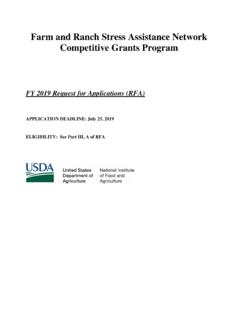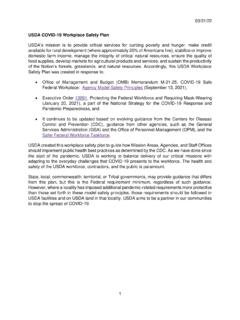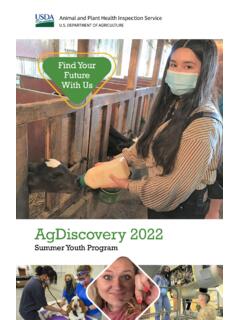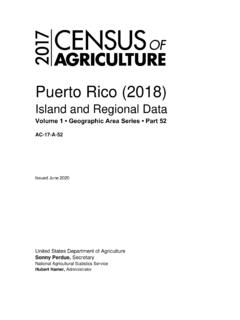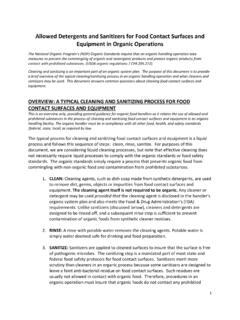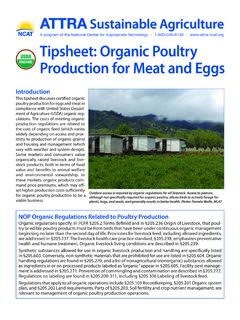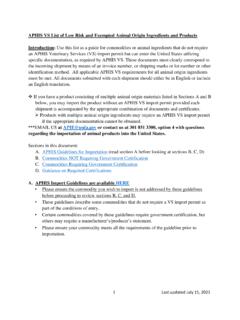Transcription of FDA Regulations and Process Validation Considerations
1 FDA Regulations and Process Validation ConsiderationsNate Anderson, Food and Drug AgenciesRegulatory Agencies Red Meat > 3% raw > 2% cooked Poultry Egg productsRegulatory Agencies Seafood Quality Grading (Grade A) HACCP Quality Management Program Fee BasedRegulatory Agencies Water (drinking and waste) Pesticides Antimicrobial InsectsRegulatory Agencies Additives Pesticides All foods not inspected by USDA Animal drugs Nutritional labeling Ingredients labelingAvenues of Compliance Governmental Acts Promulgated Regulations Policies Guidance documentsFD&CDirect/IndirectAdditivesDai ry/PMOLACFS eafoodJuiceLabels, Standards of IdentityFDA Requirements Federal Food Drug and Cosmetic Act (FFDCA) 21 CFR 110 Current Good Manufacturing Practice in Manufacturing, Packing or Holding Human FoodGMP Processes and Controls(a)Raw materials and other ingredients.
2 (2) Raw materials and other ingredients shall either not contain levels of microorganisms that may produce food poisoningor other disease in humans, or theyshall be pasteurized or otherwise treatedduring manufacturing operations so that they no longer contain levels that would cause the product to be adulterated within the meaning of the act. GMP Processes and Controls(b) Manufacturing Operations.(4) Measures such as sterilizing, irradiating, pasteurizing, freezing, refrigerating, controlling pH or controlling aw that are taken to destroy or prevent the growth of undesirable microorganisms, particularly those of public health significance, shall be adequateunder the conditions of manufacture, handling, and distribution to prevent food from being adulterated within the meaning of the act.
3 LACF Regulations Current Good Manufacturing Practice (cGMPs): 21 CFR Part 110 Low-Acid Canned Foods: 21 CFR Part 113 Acidified Foods: 21 CFR Part 114 Emergency Permit Control: 21 CFR Part 108 The Describe both recommended (should) and required (shall) items. In CFR parts 110, 113 and 114 apply to both domestic and imported Facility Registration, Filing Forms & Instructions FDA/LACF Registration Coordinator (HFS-617)Center for Food Safety & Applied Nutrition 5100 Paint BranchCollege Park, MD 20740 search keywords: FDA LACFWhat is pasteurization? Any Process , treatment, or combination thereof, that is applied to food to reduce the most resistant microorganism(s) of public health significance to a level that is not likely to present a public health risk under normal conditions of distribution and storage.
4 (NACMCF, 2006)PMO RegulationsPasteurization is defined in the PMO and 21 CFR as: 145oF for 30 minutes 161oF for 15 seconds 191oF for 1 second 194oF for seconds 201oF for seconds 204oF for seconds 212oF for secondsJuice (a) In order to meet the requirements of subpart A of this part, processors of juice products shall include in their Hazard Analysis and Critical Control Point (HACCP) plans control measures that will consistently produce, at a minimum, a 5 log ( , 10-5) reduction, for a period at least as long as the shelf life of the product when stored under normal and moderate abuse conditions .. FFDCA: Misbranding under Sec. 403 Section 403(h) A food shall be deemed to be misbranded as a pasteurized food unless: A) Subject to a safe Process prescribed as pasteurization in a : Misbranding under Sec.
5 403 B) Subject to a safe Process : I) Reasonably likely to destroy organisms of public health significance II) Is at least as effective as a Process specified by regulation III) Is effective throughout product s shelf-life when stored under normal or moderate abuse conditions IV) is documented by notification to the Secretary and not rejected within 120 days for failure to meet clauses I, II, or IIII rradiation 21 CFR 179 Irradiation in the production, processing and handling of food Covers radiation sources, general provisions, ionizing radiation, radiofrequency (and microwave), ultraviolet, pulsed light and petitioned amendments. Irradiation The use of a source of radiation that does not comply with our current Regulations requires an amendment to the Regulations through the submission of a food additive petition Example: To use higher UV intensities ( , > 1W per 5 to 10 ft2) an interested party would have to petition the agency.
6 The 2000 final rule was specific for juice products and does not apply to any other foods. The agency encourages early industry consultationFood Safety Modernization FSMA updates by E-mail!Preventive Controls Rule Preventive Controls Proposed Rule for Human Food Final Rule due Aug. 30th, 2015 FSMA exempted LACF with respect to microbiological hazards LACF processors will still have to address physicaland chemicalhazards Acidified and acid foods not exempt manufacturers of these products will have to comply with ALL FSMA requirements unless an exemption applies ( , Qualified Facility)FSMA Preventive Controls facilities are required to conduct a hazard analysis and implement preventive controls for identified hazards.
7 Preventive controls: risk-based, reasonably appropriate procedures, practices, and processesthat a person knowledgeable about the safe manufacturing, processing, packing, or holding of food would employ to significantly minimize or prevent the hazards identified in the hazard that are consistent with the current scientific understandingof safe food manufacturing, processing, packing, or holding at the time of the Requirements (Proposed) Identify and evaluate hazards Implement preventive controls for the hazards Monitor and verify preventive controls and take corrective actions if not properly implemented Keep records of these activitiesFood Safety PlanPreventive Controls Preventive controls should be implemented when pathogens in foods pose a risk.
8 Identify and evaluate known or reasonably foreseeable hazards (FSMA, Sec. 418b) Preventive controls will need to be validated. Pasteurization requires [FFDCA 403(h)] submission of a notification to FDA with the is Validation ? Validationis the collection and evaluation of scientific and technical information to determine if the treatment when properly applied, will effectively control the Advisory Committee on Microbial Criteria for Foods PasteurizationJ. of Food Protection, Vol 69, No. 5, 2006, 1190-1216 Why do we need to validate? To establish documented evidencethat provides a high degree of assurancethat a specific Process or system will consistently produce a product meeting its predetermined specifications and quality from NFPA Bulletin 43-LValidation Studies Are needed for Process technologies implemented as preventive controls for pathogen reduction in foods For equipment operating within its established control limits, microbiological Validation provides documented evidence that the Process delivers microbiological inactivation to predefined, acceptable and safe levels.
9 The Validation of preventive controls:(1) Must be performed or overseen by a qualified individual(2) Must include collecting and evaluating scientific and technical information (or .. conducting studies) to determine whether the preventive controls, when properly implemented, will effectively control the hazards that are reasonably likely to occurHuman food: 21 CFR (a)(1), (a)(2)Animal food: 21 CFR (a)(1), (a)(2) Validation within FSMAA pproaches to Validation Government guidance Safe harbors Published scientific literature Mathematical models Data from previous studies Data from new scientific experiments Any combination of these approachesValidation of Control Measures Use available scientific guidance for Studies Define the test methodology that will be used for the Process , may be technology & decontamination Process specific.
10 Identify the target organism for each specific product and Process and establish the desired log count reduction. Calibrate the resistance of the surrogate against the target pathogen for each specific product and Process . Develop a suitable inoculation method and appropriate Studies Challenge the locations in the Process and food matrix where treatment dose is expected to be lowest cold spot . Sample sufficient amounts of product to have confidence in the results Replicate Validation experiments to establish confidence in Process delivery It is useful to test to failure. Understand the boundaries between inactivation and survival Provide information for deviation evaluation Make appropriate Considerations for culture media, incubation temperature, Studies Determine the appropriate critical factors, limits and design specifications for the desired Process .






